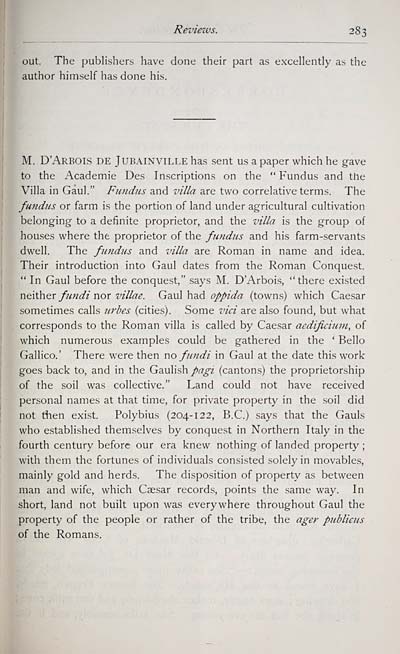Blair Collection > Celtic magazine > Volume 12
(293)
Download files
Complete book:
Individual page:
Thumbnail gallery: Grid view | List view

Revietvs. 283
out. The publishers have done their part as excellently as the
author himself has done his.
M. D'Arbois DE Jubainville has sent us a paper which he gave
to the Academie Des Inscriptions on the " Fundus and the
Villa in Gaul." Fundus and villa are two correlative terms. The
fundus or farm is the portion of land under agricultural cultivation
belonging to a definite proprietor, and the villa is the group of
houses where the proprietor of the fundus and his farm-servants
dwell. The fmdus and villa are Roman in name and idea.
Their introduction into Gaul dates from the Roman Conquest.
" In Gaul before the conquest," says M. D'Arbois, "there existed
neither fundi nor villae. Gaul had oppida (towns) which Caesar
sometimes calls Jirbes (cities). Some vici are also found, but what
corresponds to the Roman villa is called by Caesar aedificiuni, of
which numerous examples could be gathered in the ' Bello
Gallico.' There were then wo fundi in Gaul at the date this work
goes back to, and in the Gaulish pagi (cantons) the proprietorship
of the soil was collective." Land could not have received
personal names at that time, for private property in the soil did
not then exist. Polybius (204- 1 2 2, B.C.) says that the Gauls
who established themselves by conquest in Northern Italy in the
fourth century before our era knew nothing of landed property ;
with them the fortunes of individuals consisted solely in movables,
mainly gold and herds. The disposition of property as between
man and wife, which Caesar records, points the same way. In
short, land not built upon was everywhere throughout Gaul the
property of the people or rather of the tribe, the ager publieus
of the Romans.
out. The publishers have done their part as excellently as the
author himself has done his.
M. D'Arbois DE Jubainville has sent us a paper which he gave
to the Academie Des Inscriptions on the " Fundus and the
Villa in Gaul." Fundus and villa are two correlative terms. The
fundus or farm is the portion of land under agricultural cultivation
belonging to a definite proprietor, and the villa is the group of
houses where the proprietor of the fundus and his farm-servants
dwell. The fmdus and villa are Roman in name and idea.
Their introduction into Gaul dates from the Roman Conquest.
" In Gaul before the conquest," says M. D'Arbois, "there existed
neither fundi nor villae. Gaul had oppida (towns) which Caesar
sometimes calls Jirbes (cities). Some vici are also found, but what
corresponds to the Roman villa is called by Caesar aedificiuni, of
which numerous examples could be gathered in the ' Bello
Gallico.' There were then wo fundi in Gaul at the date this work
goes back to, and in the Gaulish pagi (cantons) the proprietorship
of the soil was collective." Land could not have received
personal names at that time, for private property in the soil did
not then exist. Polybius (204- 1 2 2, B.C.) says that the Gauls
who established themselves by conquest in Northern Italy in the
fourth century before our era knew nothing of landed property ;
with them the fortunes of individuals consisted solely in movables,
mainly gold and herds. The disposition of property as between
man and wife, which Caesar records, points the same way. In
short, land not built upon was everywhere throughout Gaul the
property of the people or rather of the tribe, the ager publieus
of the Romans.
Set display mode to: Large image | Transcription
Images and transcriptions on this page, including medium image downloads, may be used under the Creative Commons Attribution 4.0 International Licence unless otherwise stated. ![]()
| Early Gaelic Book Collections > Blair Collection > Celtic magazine > Volume 12 > (293) |
|---|
| Permanent URL | https://digital.nls.uk/76464253 |
|---|
| Description | Volume XII, 1887. |
|---|---|
| Shelfmark | Blair.13 |
| Attribution and copyright: |
|
| Description | A selection of books from a collection of more than 500 titles, mostly on religious and literary topics. Also includes some material dealing with other Celtic languages and societies. Collection created towards the end of the 19th century by Lady Evelyn Stewart Murray. |
|---|
| Description | Selected items from five 'Special and Named Printed Collections'. Includes books in Gaelic and other Celtic languages, works about the Gaels, their languages, literature, culture and history. |
|---|

